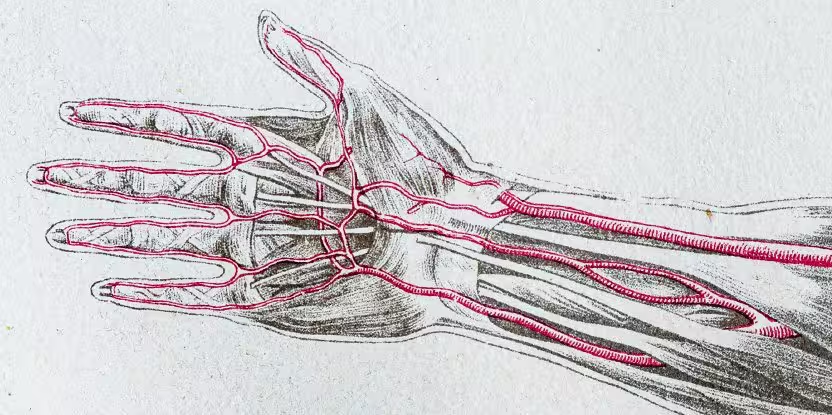6 Minutes
Small changes in our bodies can reveal big stories about how humans are still evolving. One example is the median artery — a vessel that normally appears in early embryos and usually disappears before birth, but which is becoming more common in adults. New analyses suggest this tiny blood channel is on the rise, with implications for anatomy, medicine and how we understand rapid evolutionary shifts in modern populations.
A hidden artery reappears: what researchers found
The median artery forms early in human development where it carries blood down the center of the forearm to nourish the growing hand. In typical development, this vessel regresses at around eight weeks as the radial and ulnar arteries take over. But in some cases the median artery persists through gestation and remains functional into adulthood.
Researchers from Flinders University and the University of Adelaide published a paper in 2020 showing that adults with a persistent median artery are now considerably more common than they were a century ago. By reviewing historical anatomical records and examining donated limbs, the team estimated that prevalence rose from roughly 10 percent for people born in the mid-1880s to about 30 percent for those born in the later 20th century — an increase that points to a fast-moving microevolutionary trend.

Three major arteries in the forearm, with the 'median' in the center
How scientists measured the trend and its limits
To assess how common the persistent median artery (also called the median artery of the forearm) is today, the team dissected 80 forelimbs from cadavers donated in Australia. The donors were largely of European descent and were aged 51 to 101 at death, meaning most were born in the early 20th century. The researchers noted how often a substantial median artery was present and compared their counts with reports pulled from anatomical literature going back centuries.
The comparison controlled for biases in older reports, and the combined evidence suggested a roughly threefold increase in the frequency of a functional median artery over about 100–150 years. The authors proposed several potential explanations: genetic changes affecting artery development, shifts in maternal health and prenatal conditions, or a combination of both.

Graph of one set of analyses predicts an increase in the prevalence of the median artery
Why this matters: benefits, risks and evolutionary context
At first glance, an extra blood channel in the forearm might seem like a neutral or even beneficial oddity. The persistent median artery can supply extra blood to the forearm or hand, theoretically supporting greater tissue resilience and recovery. But it also has clinical downsides: some studies link a persistent median artery to a higher risk of carpal tunnel syndrome and other compressive neuropathies, because the added vessel takes up space under the wrist.
Understanding why the trait is increasing matters beyond curiosity. Small anatomical shifts like this — and the recent rise of a small knee bone called the fabella — are examples of microevolution: incremental changes in a population that can accumulate into meaningful differences over relatively short timescales. These changes can reshape patterns of health, disease and injury in ways that modern medicine will need to adapt to.
Limits of the current data
- Sample representation: the dissection sample was from Australians of mainly European ancestry; global prevalence may differ.
- Causes remain uncertain: differentiating genetic evolution from environmental or developmental influences requires genomic and prenatal data.
- Clinical impact needs quantification: more epidemiological studies are needed to link persistent median arteries with functional outcomes across diverse populations.
What researchers want to investigate next
Future work aims to combine anatomical surveys with genetic screening and maternal health records. If specific genetic variants are associated with retention of the median artery, that would suggest a heritable shift under selection. Alternatively, changes in prenatal nutrition, maternal metabolic health, or exposure to environmental factors could alter developmental pathways so that the artery fails to regress as often.
Knowing the mechanism matters: a genetic shift implies natural selection or genetic drift, while developmental plasticity points to an environmental influence that could be reversible or predictable. Either way, the trend raises questions about how modern lifestyles, medical care and population dynamics are reshaping the human body.
Expert Insight
Dr. Elena Morris, an evolutionary anatomist, says: 'We often think of evolution as something that took place in the distant past, but traits like the persistent median artery show how dynamic our biology remains. Whether driven by genes or prenatal environments, these small anatomical changes can have real clinical consequences. Mapping their distribution across populations and tying anatomy to genomic data will be crucial for understanding the trajectory of human evolution in the 21st century.'
Researchers caution that, while the increase is striking, it is only one of many small shifts unfolding in human populations. Documenting and explaining these trends requires interdisciplinary collaboration across anatomy, genetics, epidemiology and developmental biology.
As microevolution continues to express itself in unexpected ways, clinicians and anatomists will need to update diagnostic and surgical awareness, and scientists will keep watching these subtle indicators of how our species is still changing.
Source: sciencealert
Comments
Reza
Sounds intriguing but is it genetic or just prenatal stuff? Need genomic data, plus bigger, diverse samples tho.
labcore
Wow, didn't expect human anatomy to be changing this fast. Kinda wild, also worry about carpal tunnel? hmm


Leave a Comment